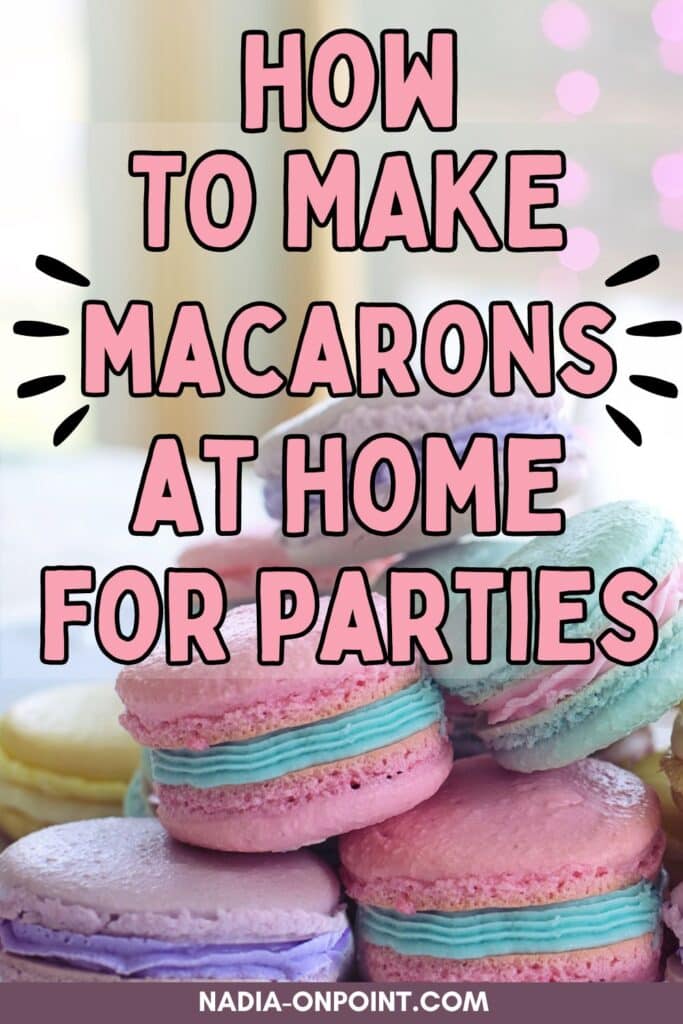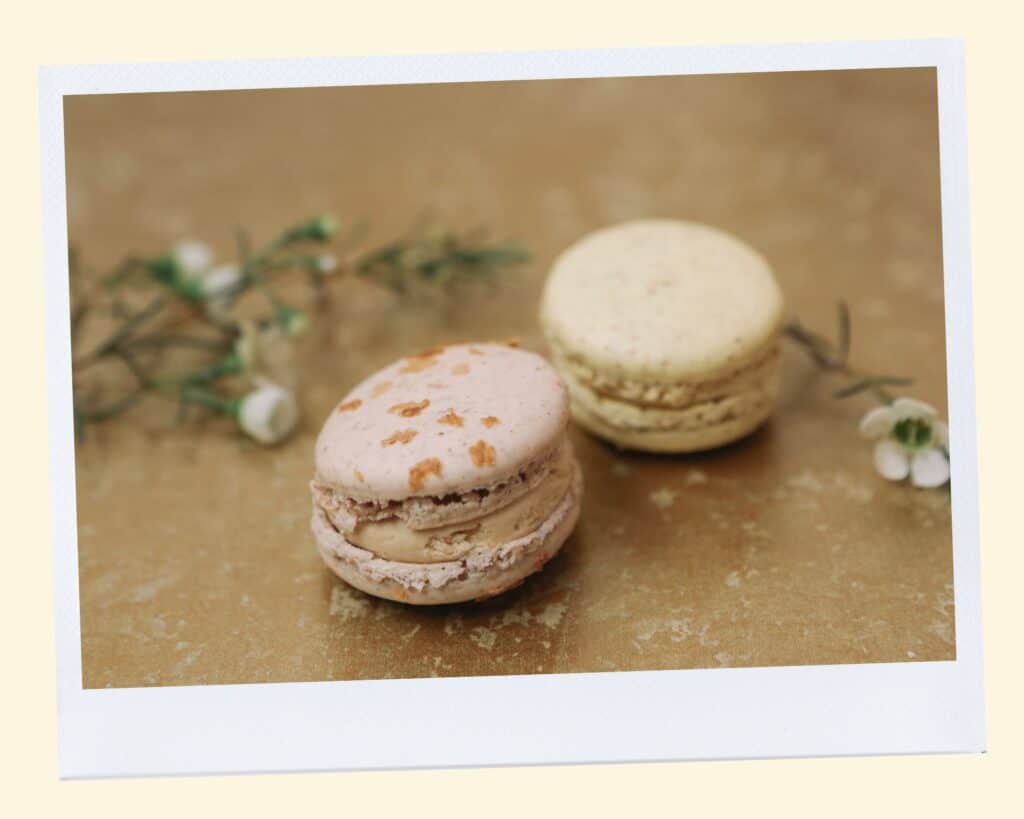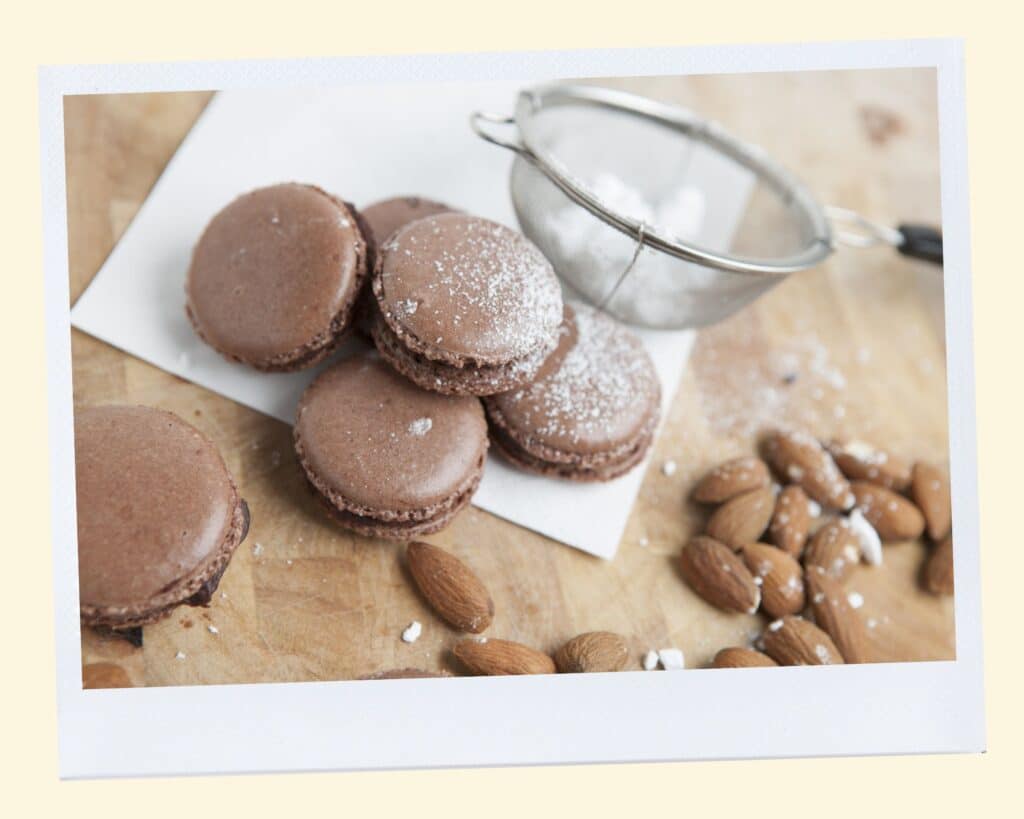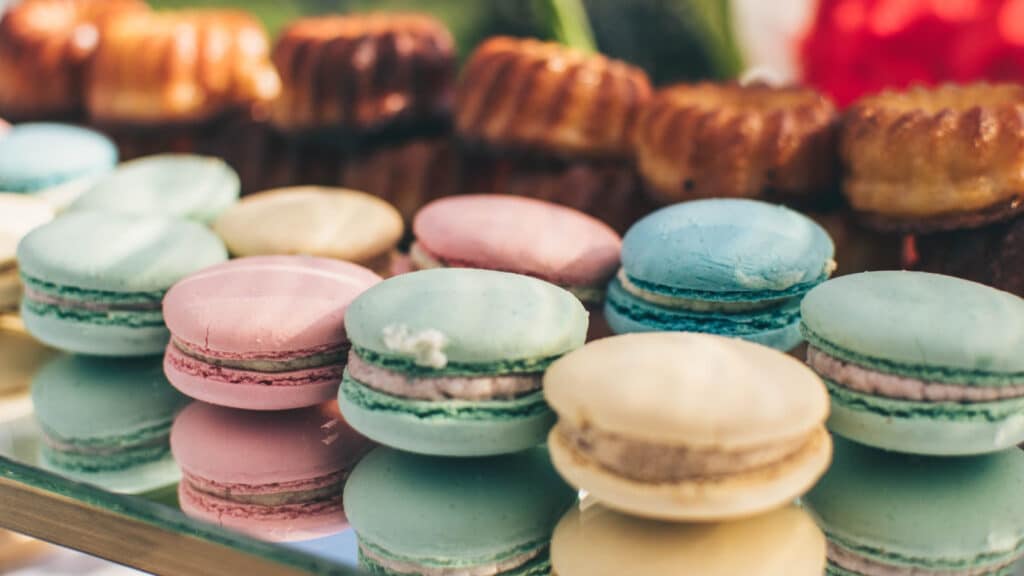Have you seen perfect rows of French macarons stacked in bakeries and wondered what makes them so special?
In this article, I explain everything you need to know about macarons, including how to make them at home.

What Are Macarons? What Is So Special About Them?
Macarons are bite-sized French pastries. A Parisian-style macaron has two meringue cookie shells sandwiched together with a smooth filling.
They are considered one of the most beautiful sweet treats in the world. Visually appealing and versatile, they boast a unique texture that is soft and chewy in the middle, with a crisper exterior. In addition, they come in as many different flavors and colors as you can dream of. Renowned French patisserie Maison Ladurée sells 15,000 macarons each day, so it is safe to say macarons are a popular treat.
Egg whites, sugar, and almond flour are used to make macarons. They have smooth, squared tops and distinctive ruffled edges or ‘feet’ formed when the shells bake and rise.
Macarons are also naturally gluten-free! Macarons are usually filled with ganache, buttercream, or jam and can sometimes be savory and sweet.
French macarons are often baked in rainbow hues using food coloring to make them even prettier and to indicate their flavor. The most popular macaron flavors include chocolate, pistachio, and coffee. Still, you will find more unusual flavors, too, like wasabi, foie gras, and sriracha!
What Is The Difference Between Macarons and Macaroons?
Macarons and macaroons are different, although it is easy to understand the confusion! Macaroons differ from macarons in almost every way, not just in the ingredients and preparation processes but also in their taste, appearance, and texture.
Macaroons are crumbly drop cookies made from shredded coconut, sugar, and egg whites. They are baked as small, individual round cookies and sometimes dipped in or decorated with chocolate. Macaroons originate from Italy, are straightforward to make, and have a rustic taste and appearance.
Macarons are the French meringue shell sandwich described above. They come in various colors and flavors, and unfortunately, they are much more challenging and take skill and patience to get right.
Macarons Origin

In 1930, French pastry chef Pierre Desfontaines created macarons in the Parisian style by sandwiching two meringue cookie shells with a filling. But the origins of macarons date back much further. According to the culinary encyclopedia Larousse Gastronomique, macarons can be traced back to a monastery in Cormery, France, in the 8th century!
There are also tales of Catherine de Medici bringing macaron-style cookies over from Italy, nuns baking them during the French revolution, and several other chefs, including Claude Gerbet, claiming the invention too. One clear thing is that macarons are universally famous, and everyone wants a piece of the action.
Over the years, macarons have become synonymous with style, taste, and elegance. These days macarons are a perfect example of classic French pastries, often served with afternoon tea or as a petit four with coffee after dinner.
Why Are Macarons Hard To Make?
Macarons are hard to make because the preparation process is precise, and any small change can significantly impact the outcome. I am sharing a base macaron recipe with you today, but you can always sign up for an online macaron class to perfect your macaron baking skills!
The ingredients are basic but prepared in a particular way, and many issues can arise during the process. Macarons can crack, go flat or crooked, have a rough surface, or come out of the oven hollow, to name a few potential problems.
Making macarons requires precision and patience, and practice! Discovering what has caused them to go wrong can be a mystery. The freshness of the eggs, the humidity of the kitchen, or even stirring the batter too many times or not enough times can ruin a batch.
Ways To Make Macarons
You can prepare macarons in different ways. However, the most common methods to make macarons are Italian and French. The difference between these two methods is how the meringue is made and combined with almond flour and sugar.
The French method involves whipping egg whites and adding fine sugar to make meringue. Next, fold ground almonds and powdered sugar into the meringue (known as the “macaronage”), pipe the mixture onto trays, and bake.
The Italian method uses hot sugar syrup whipped with egg whites to form a more stable meringue. Then, an almond paste made from sugar, almond flour, and egg whites is mixed with the Italian meringue to make macaron batter.
The French method is sometimes seen as easier as it does not involve boiling sugar syrup but requires much more delicate mixing. The Italian form makes the macaronage process easier.
One of the most common problems with making macarons is overmixing the batter, which will result in flat macarons. The egg whites in Italian meringue cooked with hot sugar syrup makes it more stable, and you are less likely to overmix it.
How To Make Macarons at Home

This foolproof French macarons recipe blends French and Italian methods. You might be surprised by how simple the macaron ingredients are, but the more intricate part is how they are combined.
The two crucial steps are a strong meringue and an appropriate macaronage folding technique.
Once baked, pipe macarons with jam, ganache, or buttercream filling and try different combinations.
Ingredients
- ½ cup (110 g) Egg whites (divided into two portions)
- 1 ½ cup (150 g) Almond flour
- 1 ½ cup (150 g) Powdered sugar (confectioners/icing sugar)
- 2.5 tablespoons (30 g) Fine sugar
- ⅔ cup (120 g) Granulated sugar
- ⅕ cup (50 g) Water
The recipe makes 20-25 macarons. US customary cup measurement is an indicative figure only; most pastry chefs recommend measuring the ingredients with a digital scale by weight. Baking macarons requires precision and accuracy.
Equipment
You will need a rubber spatula, a stand mixer with a whisk attachment, a sugar thermometer, piping bags with a round tip, silicon baking mats (or trays lined with parchment paper), and a digital oven thermometer.
While the technique and instructions can be pretty complex, macarons only take around 30 minutes to make, so it’s crucial to have all the equipment ready.
Instructions
- Measure the ingredients and have them ready at hand.
- Make the sugar syrup by boiling granulated sugar with water in a saucepan.
- Whisk half the egg white on low/medium and slowly add the superfine sugar when they become foamy and form stiff peaks.
- Monitor the sugar syrup with a thermometer. When it reaches 244-248 F, remove it from the heat and slowly pour it into the whipped egg whites while whisking. The Italian meringue will become shiny and sticky with stiff peaks. Add food coloring at the end.
- Mix the remaining egg whites with the almond flour and powdered sugar to form a marzipan paste.
- Gently fold the meringue into the marzipan mixture in three stages with a rubber spatula. Take care not to overmix it.
- Move the macaron batter into a piping bag and pipe small circles onto lined baking trays, leaving a small gap between each one.
- Tap the baking sheet on the counter a few times to pop any air bubbles, and allow the macarons to rest for 25-40 minutes.
- Preheat the oven to 311 F (no fan).
- Bake the macarons for 14-15 minutes, then allow them to cool completely on the trays.
- Prepare your macaron filling, place it into a piping bag, and let it rest and thicken in the fridge.
- Pipe filling onto one macaron shell and sandwich it with another. Try to match the sizes of the macaron shells evenly.
- Place the macarons in the fridge for several hours or overnight to allow them to reach the right chewy texture.
Tips for Making Macarons From The Macaron Expert
- Clean all the utensils first to remove traces of fat, and wipe down the mixing bowl and the whisk attachment with vinegar.
- Use room-temperature egg whites for the meringue. Take extreme care separating them from the egg yolk so that no egg yolk is present in the egg whites.
- Use high-quality powder food coloring or concentrated gel food coloring that will not fade while baking. Liquid food coloring changes the consistency of the batter and causes problems, so avoid it.
- Don’t overmix the macaron batter. It is ready when you lift the spatula over the mixture, and the batter falls slowly, forming a ribbon.
- Using a digital oven thermometer, check that you are baking macarons at the correct temperature.
- Use a template to help pipe even circles of macaron batter around 1.5 inches in diameter.
- Let the macarons rest before enjoying them so that they soften and reach the right texture.
Master The Art of Macarons
Macarons are the perfect bite-sized treat to make as gifts or serve for your guests. They look as delectable as they taste, and they are fun to bake, too! They might take a bit of practice, so don’t be discouraged if they don’t turn out right the first time.
Whether you’re looking to throw a special event or elevate coffee time, macarons are a culinary challenge worth trying.This article originally appeared on Wealth of Geeks.
More Ideas from this Category
About the author
Katalin Nagy
Katalin Nagy once was a home baker like who tried tons of recipes and learned the hard way by testing and adjusting. Fast forward to today, she completed several high-quality pastry courses, became a trained pastry chef and shares her knowledge with the world at Spatula Desserts. Her mission is to teach you how to bake like a Pro in a home kitchen environment with the help of her foolproof recipes, baking tutorials, and Online Baking classes.

